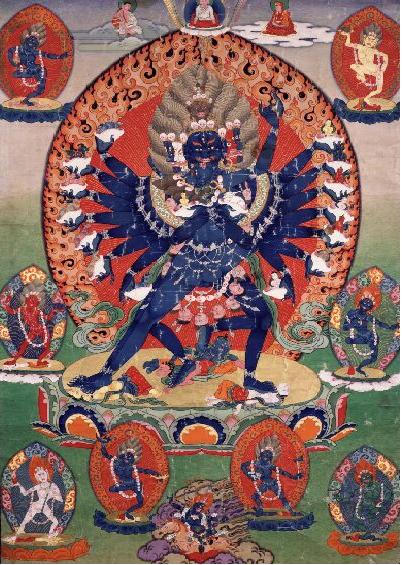|
Buddhist Tantras
The Buddhist Tantras are a varied group of Indian and Tibetan texts which outline unique views and practices of the Buddhist tantra religious systems. Overview Buddhist Tantric texts began appearing in the Gupta Empire period, though there are texts with elements associated with Tantra that can be seen as early as the third century. By the eighth century, Tantra was a dominant force in North India and the number of texts increased with numerous Tantric pandits writing commentaries. The earliest known datable Buddhist Tantra is possibly the Mahavairocana Tantra, which was mentioned and collected by the Chinese pilgrim Wu-xing (無行) c. 680 CE. Some of the material is also similar to content in the Yoga Upanishads. Buddhist Tantric traditions were variously influenced by Śaiva and Pancharatra Hindu traditions, local god/goddess cults, Yaksha or nāga rites, as well as drawing on pre-existing Mahāyāna Buddhist ideas and practices. Many early Buddhist Tantric texts, later ter ... [...More Info...] [...Related Items...] OR: [Wikipedia] [Google] [Baidu] |
Antinomian
Antinomianism (Ancient Greek: ἀντί 'anti''"against" and νόμος 'nomos''"law") is any view which rejects laws or legalism and argues against moral, religious or social norms (Latin: mores), or is at least considered to do so. The term has both religious and secular meanings. In some Christian belief systems, an antinomian is one who takes the principle of salvation by faith and divine grace to the point of asserting that the saved are not bound to follow the moral law contained in the Ten Commandments. The distinction between antinomian and other Christian views on moral law is that antinomians believe that obedience to the law is motivated by an internal principle flowing from belief rather than from any external compulsion. John Eaton, a leader in the antinomian underground during the 1630s, interpreted Revelation 12:1 with a quote recorded by Giles Firmin: ''"I saw a Woman Clothed with the Sun'' hat is, the Church Clothed with the righteousness of Christ, to her Ju ... [...More Info...] [...Related Items...] OR: [Wikipedia] [Google] [Baidu] |
Buddhism In Mongolia
Buddhism is the largest and official religion of Mongolia practiced by 53% of Mongolia's population, according to the 2010 Mongolia census. Buddhism in Mongolia derives much of its recent characteristics from Tibetan Buddhism of the Gelug and Kagyu lineages, but is distinct and presents its own unique characteristics. Buddhism in Mongolia began with the Yuan dynasty (1271-1368) emperors' conversion to Tibetan Buddhism. The Mongols returned to shamanic traditions after the collapse of the Mongol Empire, but Buddhism reemerged in the 16th and 17th centuries. Characteristics Buddhism in Mongolia derives many of its recent characteristics from Tibetan Buddhism of the Gelug and Kagyu lineages, but is distinct and presents its own unique characteristics. Traditionally, the Mongolian ethnic religions involved worship of Heaven (the "eternal blue sky") and ancestors and the ancient North Asian practices of shamanism, in which human intermediaries went into trance and sp ... [...More Info...] [...Related Items...] OR: [Wikipedia] [Google] [Baidu] |
Newar Buddhism
Newar Buddhism is the form of Vajrayana Buddhism practiced by the Newar people of the Kathmandu Valley, Nepal. It has developed unique socio-religious elements, which include a non-monastic Buddhist society based on the Newar caste system and patrilineality. The ritual priestly (''guruju'') caste, vajracharya (who perform rituals for others) and ''shakya'' (who perform rituals mostly within their own families) form the non-celibate religious clergy caste while other Buddhist Newar castes like the Urāy act as patrons. Uray also patronise Tibetan Vajrayana, Theravadin, and even Japanese clerics. It is the oldest known sect of the Vajrayana tradition outdating the Tibetan school of Vajrayana by more than 600 years. Although there was a vibrant regional tradition of Buddhism in the Kathmandu Valley during the first millennium, the transformation into a distinctive cultural and linguistic form of Buddhism appears to have taken place in the fifteenth century, at about the same t ... [...More Info...] [...Related Items...] OR: [Wikipedia] [Google] [Baidu] |
Shingon
Shingon monks at Mount Koya is one of the major schools of Buddhism in Japan and one of the few surviving Vajrayana lineages in East Asia, originally spread from India to China through traveling monks such as Vajrabodhi and Amoghavajra. Known in Chinese as the Tangmi (; the Esoteric School in Tang Dynasty of China), these esoteric teachings would later flourish in Japan under the auspices of a Buddhist monk named Kūkai (), who traveled to Tang China to acquire and request transmission of the esoteric teachings. For that reason, it is often called Japanese Esoteric Buddhism, or Orthodox Esoteric Buddhism. The word ''shingon'' is the Japanese reading of the Chinese word ('), which is the translation of the Sanskrit word ("mantra"). History Shingon Buddhist doctrine and teachings arose during the Heian period (794-1185) after a Buddhist monk named Kūkai traveled to China in 804 to study Esoteric Buddhist practices in the city of Xi'an (), then called Chang-an, at ... [...More Info...] [...Related Items...] OR: [Wikipedia] [Google] [Baidu] |
Tangmi
Chinese Esoteric Buddhism refers to traditions of Tantra and Esoteric Buddhism that have flourished among the Chinese people. The Tantric masters Śubhakarasiṃha, Vajrabodhi and Amoghavajra, established the Esoteric Buddhist ''Zhenyan'' (, "true word", "mantra") tradition from 716 to 720 during the reign of Emperor Xuanzong of Tang. It employed mandalas, mantras, mudras, abhiṣekas, and deity yoga. The Zhenyan tradition was transported to Japan as Shingon Buddhism by Kūkai as well as influencing Korean Buddhism. The Song dynasty (960–1279) saw a second diffusion of Esoteric texts. Esoteric Buddhist practices continued to have an influence into the late imperial period and Tibetan Buddhism was also influential during the Yuan dynasty period and beyond. In the Ming dynasty (1368–1644) through to the modern period, esoteric practices and teachings became absorbed and merged with the other Chinese Buddhist traditions to a large extent. In Chinese these traditions are also ter ... [...More Info...] [...Related Items...] OR: [Wikipedia] [Google] [Baidu] |
Tang Dynasty
The Tang dynasty (, ; zh, t= ), or Tang Empire, was an imperial dynasty of China that ruled from 618 to 907 AD, with an interregnum between 690 and 705. It was preceded by the Sui dynasty and followed by the Five Dynasties and Ten Kingdoms period. Historians generally regard the Tang as a high point in Chinese civilization, and a golden age of cosmopolitan culture. Tang territory, acquired through the military campaigns of its early rulers, rivaled that of the Han dynasty. The Lǐ family () founded the dynasty, seizing power during the decline and collapse of the Sui Empire and inaugurating a period of progress and stability in the first half of the dynasty's rule. The dynasty was formally interrupted during 690–705 when Empress Wu Zetian seized the throne, proclaiming the Wu Zhou dynasty and becoming the only legitimate Chinese empress regnant. The devastating An Lushan Rebellion (755–763) shook the nation and led to the decline of central authority in the dynasty' ... [...More Info...] [...Related Items...] OR: [Wikipedia] [Google] [Baidu] |
Southeast Asia
Southeast Asia, also spelled South East Asia and South-East Asia, and also known as Southeastern Asia, South-eastern Asia or SEA, is the geographical south-eastern region of Asia, consisting of the regions that are situated south of mainland China, east of the Indian subcontinent, and north-west of mainland Australia. Southeast Asia is bordered to the north by East Asia, to the west by South Asia and the Bay of Bengal, to the east by Oceania and the Pacific Ocean, and to the south by Australia and the Indian Ocean. Apart from the British Indian Ocean Territory and two out of 26 atolls of Maldives in South Asia, Maritime Southeast Asia is the only other subregion of Asia that lies partly within the Southern Hemisphere. Mainland Southeast Asia is completely in the Northern Hemisphere. East Timor and the southern portion of Indonesia are the only parts that are south of the Equator. The region lies near the intersection of geological plates, with both heavy seismi ... [...More Info...] [...Related Items...] OR: [Wikipedia] [Google] [Baidu] |
Nepal
Nepal (; ne, :ne:नेपाल, नेपाल ), formerly the Federal Democratic Republic of Nepal ( ne, सङ्घीय लोकतान्त्रिक गणतन्त्र नेपाल ), is a landlocked country in South Asia. It is mainly situated in the Himalayas, but also includes parts of the Indo-Gangetic Plain, bordering the Tibet Autonomous Region of China China–Nepal border, to the north, and India India–Nepal border, in the south, east, and west, while it is narrowly separated from Bangladesh by the Siliguri Corridor, and from Bhutan by the States and union territories of India, Indian state of Sikkim. Nepal has a Geography of Nepal, diverse geography, including Terai, fertile plains, subalpine forested hills, and eight of the world's ten List of highest mountains#List, tallest mountains, including Mount Everest, the highest point on Earth. Nepal is a multi-ethnic, multi-lingual, multi-religious and multi-cultural state, with Nepali langua ... [...More Info...] [...Related Items...] OR: [Wikipedia] [Google] [Baidu] |
Tibet
Tibet (; ''Böd''; ) is a region in East Asia, covering much of the Tibetan Plateau and spanning about . It is the traditional homeland of the Tibetan people. Also resident on the plateau are some other ethnic groups such as Monpa, Tamang, Qiang, Sherpa and Lhoba peoples and now also considerable numbers of Han Chinese and Hui settlers. Since 1951, the entire plateau has been under the administration of the People's Republic of China, a major portion in the Tibet Autonomous Region, and other portions in the Qinghai and Sichuan provinces. Tibet is the highest region on Earth, with an average elevation of . Located in the Himalayas, the highest elevation in Tibet is Mount Everest, Earth's highest mountain, rising 8,848.86 m (29,032 ft) above sea level. The Tibetan Empire emerged in the 7th century. At its height in the 9th century, the Tibetan Empire extended far beyond the Tibetan Plateau, from Central Asian's Tarim Basin and the Pamirs in the west to Yunnan ... [...More Info...] [...Related Items...] OR: [Wikipedia] [Google] [Baidu] |
Hevajra Tantra
Hevajra (Tibetan: kye'i rdo rje / kye rdo rje; Chinese: 喜金剛 Xǐ jīngāng / 呼金剛 Hū jīngāng;) is one of the main yidams (enlightened beings) in Tantric, or Vajrayana Buddhism. Hevajra's consort is Nairātmyā (Tibetan: bdag med ma). History India The Hevajra Tantra, a yoginītantra of the ''anuttarayogatantra'' class, is believed to have originated between the late 8th (Snellgrove), and the late 9th or early 10th centuries (Davidson), in Eastern India, possibly Kamarupa. Tāranātha lists Saroruha and Kampala (also known as "Lva-va-pā", "Kambhalī", and "Śrī-prabhada") as its "bringers": .. the foremost yogi Virupa meditated on the path of Yamāri and attained siddhi under the blessings of Vajravārāhi,...His disciple Dombi Heruka..understood the essence of the Hevajra Tantra, and composed many śāstras like the ''Nairātmā-devi-sādhana'' and the ''Sahaja-siddhi''. He also conferred abhiṣeka on his own disciples. After this, two ācāryas Lva-va-p ... [...More Info...] [...Related Items...] OR: [Wikipedia] [Google] [Baidu] |








